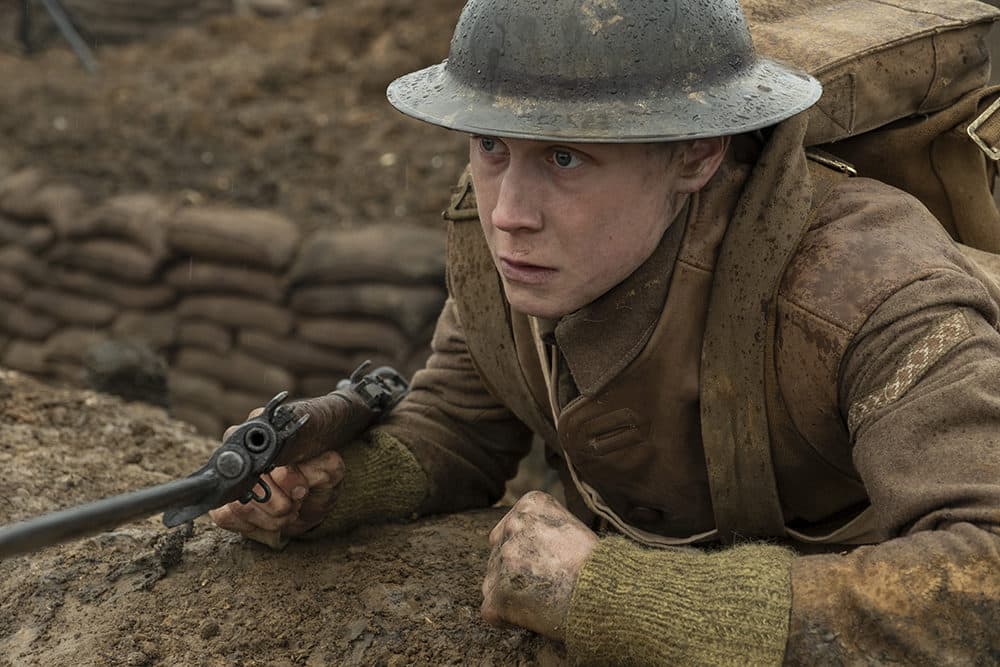Advertisement
Bringing The Vision Of '1917' To Life
Resume
Oscar-winning Sam Mendes’s epic war film “1917” was not shot in all one take, but it certainly feels like it.
Oscar-winning editor Lee Smith says his job was to take eight-minute scenes and perfectly transition them together to make it seem like one shot.
“My job was not just to put the two shots together, which I had to do in a big hurry, because each choice informed how the set up was for the next shot,” Smith says. “Really, it was about checking performance, talking to Sam [Mendes] on a daily basis, checking pacing, rhythms, the accumulative effect as you start putting the film together.”
Cinematographer Roger Deakins, also an Oscar-winner, says nailing down the style and feel of the film, along with the actors’ rehearsals, took months of preparation. To match all the shots together, the crew could only film under cloud cover. He says a lot of days were spent anxiously waiting for a cloud to pass by for them to shoot.
At the heart of “1917” — starring George MacKay and Dean-Charles Chapman, among others — is a story about two scared young soldiers trying to deliver a message warning of a German attack during World War I. Mendes dedicated the film to his grandfather, who was a messenger in the war.
Smith says the meticulous detail that went into making the war film was a sign of respect for the many people who lost their lives.
“In the end,” he says, “it's a story of bravery and doing the right thing and trying to save 1,600 men from slaughter.”
Interview Highlights
On lighting a film that takes place over the course of a day
Roger Deakins: “Well that was the hardest thing of the day exteriors. … But also, I mean, just in terms of the mood of the piece and technically matching from one shot to another, we had to shoot in cloud. So that was a bit of an anxious moment on the first day of the shoot when there wasn't a cloud in the sky and we couldn't shoot anything. That was a bit anxious.”
“We rehearsed a lot. And then the second day, we got a lovely cloud cover and we shot two days work in one day. So that's how it went during the shoot when the sun was out. We wouldn't shoot. We'd rehearse and rehearse and just wait. And a lot of time was spent watching the sky, waiting for a cloud to come along that was long enough that we could do a shot under.”
On the technical work behind “1917”
RD: “... There was a lot of technical work just working out [the actors’] moves in relation to the camera. But once they got that down, they could get into the character that could actually be that character for eight minutes, or up to eight minutes, knowing that there wasn't going to be a cut. I think they really enjoyed it.”
On finding seamless transitions
Lee Smith: “Again, these were highly planned. They came to us from the set with all the best intention in the world. So really, you could only do this film with that level of preproduction and thought because if the light doesn't match, if the continuity is not right on the actors, even if the performances are not matching, if you don't have a director who's got the entire film in his head, for example, it just would have been a rolling disaster.”
“I was more worried about the accumulative pacing issues, [those issues] were always at the forefront of my mind as far as really building the film in a linear sense. And Sam [Mendes] and I discussed this at great length before saying you don't have traditional post-production techniques that I can apply to the movie. It has to be on a daily basis. You literally have to make this film day by day. And if there's a problem, then it's my job to talk to Sam and say, you know, something's not right. We need to think this through.”
On one scene where a plane crashes at the feet of two soldiers, and what it took to pull off that effect
RD: “Obviously, this is a combination of elements that are filmed separately and then composite two together. Whether it's digital effects or mechanical effects, you're using all the state of the art techniques that are available to you.”
LS: “You know. that was an interestingly complex sequence, even though it looks easy and it was all mapped out and shot. And as Roger's saying, the planes were put in later and there were separate elements that went into that, both live action and CGI, after the thing was shot. ... So hopefully it looks effortless, but there was a lot of energy went into that and some very good line ups and just a lot of precision.”
On the human side of “1917”
RD: “I think that the strength of the film is that it's not a history lesson, that it is this personal story about these two characters and this appalling situation. And you think about those young guys that left Britain to go to fight on the continent. Most of them were country boys had never been abroad before. So, you know, it must be been all that more terrifying to be sort of in such a different world.”
LS: “Whenever you're dealing with a war story, you have to show respect. A lot of people lost their lives. And I think with all of the detail that went into the making of this film, from the production design to the dialog, keeping a sense of reality, I think was incredibly important.”
Emiko Tamagawa produced and edited this interview for broadcast with Todd Mundt. Serena McMahon adapted it for the web.
This segment aired on December 26, 2019.

